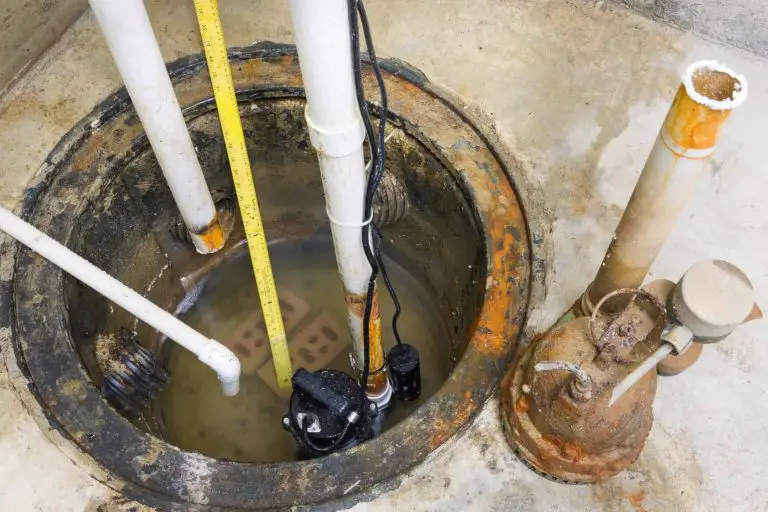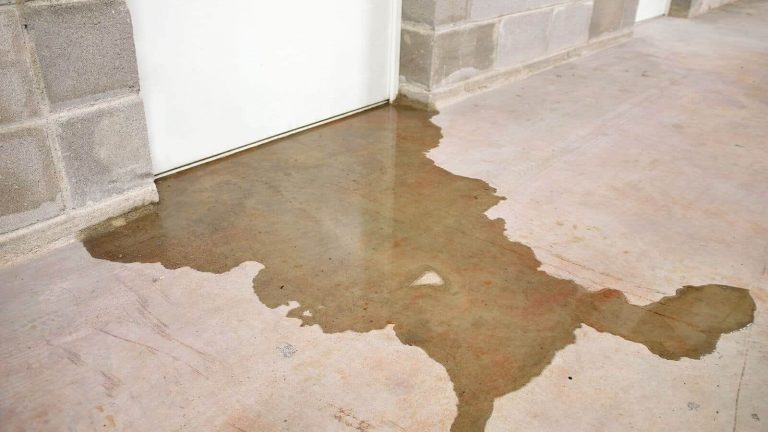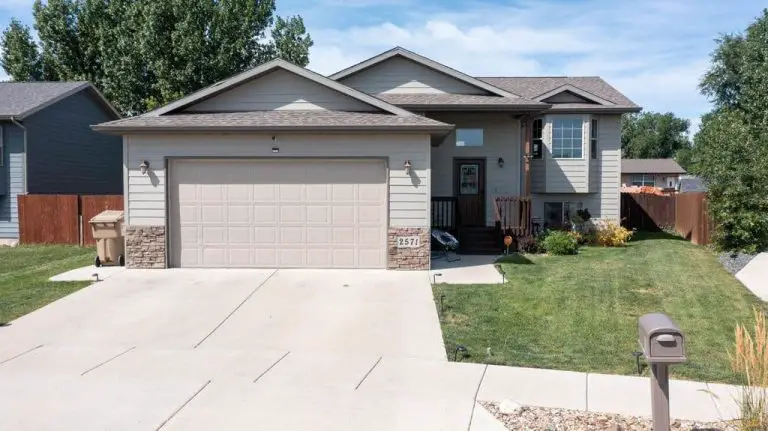Can You Bury Sump Pump Discharge Pipe
When it comes to managing water in your home, a sump pump is an indispensable tool. It helps to prevent basement flooding by directing excess water away from your foundation. However, the discharge pipe that carries the water away can be unsightly and even hazardous if left unattended. If you’re wondering what to do with your sump pump discharge pipe, one question that may come to mind is whether you can bury it. In this article, we’ll explore the pros and cons of burying a sump pump discharge pipe and provide you with all the information you need to make an informed decision.
Reasons to bury sump pump discharge pipe
Burying the sump pump discharge pipe comes with several benefits. Firstly, it prevents tripping hazards and damage to the pipe. If the pipe is left exposed, it can be a potential hazard for anyone walking around the area. Additionally, lawn mowers or other equipment can damage the pipe if it is not buried properly.
Secondly, burying the pipe is aesthetically pleasing and improves curb appeal. An exposed pipe can be an eyesore and detract from the overall appearance of your property. By burying it, you can maintain a neat and tidy appearance.
Lastly, burying the sump pump discharge pipe protects it from freezing during winter months. When temperatures drop below freezing, water in an exposed pipe can freeze and cause damage to both the pipe and your sump pump system. By burying it below the frost line, you can prevent this issue.
To bury your sump pump discharge pipe properly, there are a few steps you should follow. First, check local regulations and obtain necessary permits before beginning any work. Next, dig a trench for the pipe that is deep enough to be below the frost line and wide enough to accommodate proper slope and alignment.
Once you have dug your trench, install the pipe with proper slope and alignment to ensure effective drainage away from your home’s foundation. Be sure to backfill the trench carefully, avoiding damage to the pipe as you go.
To maintain your buried sump pump discharge pipe system properly, there are a few tips to keep in mind. Regularly inspect and clean the system to ensure proper functioning. Consider using a filter to prevent debris buildup which can cause clogs or other issues down the line. And lastly, be aware of potential clogs and address them promptly before they cause any problems.
By following these steps for burying your sump pump discharge pipe correctly and maintaining it well over time, you can enjoy all of its benefits without any issues or concerns about its functionality or appearance on your property.
Prevents tripping hazards and damage to the pipe
Burying the sump pump discharge pipe has several benefits, one of which is preventing tripping hazards and damage to the pipe. When the pipe is above ground, it can be a potential hazard for people walking around the house. Moreover, lawn mowers or other garden equipment can accidentally hit the pipe and cause damage.
By burying the sump pump discharge pipe, you eliminate these risks and ensure that your property remains safe. The pipe will be out of sight and out of mind, which means that you won’t have to worry about accidents or maintenance issues.
However, it’s important to note that burying the pipe requires careful planning and execution. You need to make sure that it’s done correctly to avoid any problems down the line. This includes checking local regulations and obtaining necessary permits before starting any work.
Once you have obtained all necessary permits, you can start digging a trench for the pipe. The trench should be deep enough to accommodate the pipe with proper slope and alignment for efficient water flow. It’s essential to ensure that there are no sharp bends in the pipeline as they can cause clogs or blockages.
After installing the pipeline, backfilling should be done carefully while avoiding damage to the newly installed pipeline. Once everything is in place, regular inspection and cleaning are necessary to maintain optimal performance.
In conclusion, burying your sump pump discharge pipe offers many benefits such as eliminating tripping hazards and protecting your pipes from accidental damage. However, it’s crucial to follow proper procedures during installation and maintenance for long-lasting results.
Aesthetically pleasing and improves curb appeal
Burying your sump pump discharge pipe can also improve the overall aesthetic of your property and boost its curb appeal. As the pipe is out of sight and out of mind, it won’t disrupt or detract from the beauty of your garden or other outdoor spaces. Moreover, you won’t have to worry about unsightly pipes being seen by neighbourhood visitors.
Additionally, burying the pipe can help enhance the security of your home by making it less obvious to potential intruders. When the pipe is visible above ground, it can be a sign that there may be something valuable inside that needs protecting – such as expensive electronics or valuables – thus making it an attractive target for burglars. However, if the pipe is buried, it can be much harder for an intruder to identify and access the valuable items in your home.
Protects the pipe from freezing during winter months
During the winter months, sump pump discharge pipes can be vulnerable to freezing. When water freezes, it expands and can cause the pipe to crack or burst, leading to costly repairs. Burying the sump pump discharge pipe can help protect it from freezing and ensure that it continues to function properly.
By burying the discharge pipe, the ground acts as a natural insulator, helping to keep the water flowing freely. This is especially important in areas where temperatures frequently drop below freezing. Without proper insulation, the water in the pipe could freeze and cause damage.
Burying the sump pump discharge pipe also helps protect it from other potential hazards such as accidental damage from lawn equipment or foot traffic. By burying the pipe, you eliminate any tripping hazards and improve overall safety around your home.
When burying a sump pump discharge pipe, it’s important to follow proper installation procedures. This includes checking local regulations and obtaining necessary permits before beginning work. Once you have obtained any necessary permits, you can begin digging a trench for the pipe. The trench should be deep enough to accommodate the size of your pipe and should be sloped away from your home to prevent water from pooling near your foundation.
After installing the pipe with proper slope and alignment, carefully backfill the trench while avoiding any damage to the newly installed piping system. Finally, consider implementing regular maintenance practices such as inspecting and cleaning your system on a regular basis and using filters if necessary to prevent debris buildup.
Overall, burying your sump pump discharge pipe not only protects it from freezing during winter months but also improves safety around your home by eliminating tripping hazards and improving curb appeal by keeping unsightly pipes out of sight.
Steps for burying sump pump discharge pipe
Burying a sump pump discharge pipe is a great way to improve the appearance of your yard and protect the pipe from damage. However, it’s important to follow the proper steps to ensure that the pipe is installed correctly.
The first step in burying a sump pump discharge pipe is to check local regulations and obtain any necessary permits. This will vary depending on where you live, so be sure to do your research beforehand.
Once you have the necessary permits, it’s time to dig a trench for the pipe. The trench should be deep enough so that the pipe is completely buried, but not so deep that it becomes difficult to access if repairs are needed. The width of the trench should also be wide enough to accommodate the size of the pipe.
After digging the trench, it’s important to install the pipe with proper slope and alignment. The slope should be at least 1/8 inch per foot away from your house or foundation, and it should also slope away from any other structures on your property. Proper alignment will ensure that water flows smoothly through the pipe without any blockages.
Once the pipe is properly installed, it’s time to backfill the trench carefully. Be sure to avoid damaging the pipe during this process by using soft soil or sand around it. Any hard objects or rocks could cause damage or even puncture holes in the pipe.
To maintain your buried sump pump discharge pipe, regular inspections and cleaning are essential. Debris buildup can cause clogs and prevent water from flowing through properly, so consider using a filter in your system as well. If you notice any potential clogs or issues with your system, address them promptly before they become bigger problems.
By following these steps and tips for maintaining your buried sump pump discharge pipe, you can enjoy an aesthetically pleasing yard while also protecting your home from potential water damage.
Check local regulations and obtain necessary permits
It is important to always check local regulations and obtain necessary permits before burying your sump pump discharge pipe. Different locations may have different requirements, so it’s essential to research these requirements in order to ensure that you are following all of the rules. In some cases, a permit may be needed for the installation of new piping systems or for making any changes to existing ones. If this is the case in your area, obtaining a permit should be the first step taken before beginning work on your project. Additionally, if you need assistance in understanding local regulations or obtaining necessary permits, don’t hesitate to contact your local building department or plumbing contractor for help.
Dig a trench for the pipe
When burying a sump pump discharge pipe, it is important to dig a trench that will accommodate the size of the pipe and allow for proper drainage. The trench should be deep enough to prevent the pipe from freezing during winter months but not so deep that it becomes difficult to access or repair.
To begin digging the trench, it is important to mark out the path of the pipe and ensure that there are no obstacles in the way. This can be done using spray paint or flags. It is also important to check with local regulations and obtain any necessary permits before beginning work.
Once the path has been marked out, use a shovel or trencher to excavate the soil along the path of the pipe. The depth of the trench will depend on factors such as climate and local regulations, but typically it should be at least 12 inches deep.
After digging the trench, it is important to install the pipe with proper slope and alignment. The slope should be at least 1/8 inch per foot away from your home’s foundation and towards a suitable drainage area. This will ensure that water flows away from your home and does not pool around your foundation.
When installing the pipe, make sure that all joints are properly sealed to prevent leaks. It may also be necessary to add couplings or other fittings depending on how long your run of pipe is.
After installing the pipe, carefully backfill the trench making sure not to damage or crush the pipe. Use soil that was removed from digging as much as possible, tamping down each layer as you go.
In conclusion, digging a proper trench for burying a sump pump discharge pipe is crucial for ensuring proper drainage away from your home’s foundation. Taking care when excavating and installing the pipe will help prevent future problems such as clogs or leaks in your system.
Install the pipe with proper slope and alignment
When burying a sump pump discharge pipe, it is essential to install the pipe with proper slope and alignment. This ensures that the water flows away from the house and towards the designated drainage area.
The first step is to determine the location of the drainage area and the end point of the pipe. Once you have identified these points, you can start digging a trench for the pipe. The trench should be deep enough to allow for proper slope and alignment, typically around 10-12 inches deep.
Next, install the pipe in the trench with proper slope and alignment. The recommended slope for a sump pump discharge pipe is at least 1/8 inch per foot. This means that for every foot of horizontal distance, there should be a drop of 1/8 inch or more in elevation.
It’s important to ensure that all connections are secure and watertight before backfilling the trench. Any leaks in the system could cause water damage or erosion over time.
Proper alignment is also crucial when installing a sump pump discharge pipe. The pipe should be straight and level to prevent any kinks or bends that could obstruct water flow or cause clogs.
Overall, installing a sump pump discharge pipe with proper slope and alignment will help ensure that your system functions effectively and efficiently for years to come.
Backfill the trench carefully, avoiding damage to the pipe
When burying a sump pump discharge pipe, it is important to backfill the trench carefully to avoid damaging the pipe. Backfilling involves replacing the soil around the pipe after it has been installed. If done improperly, backfilling can cause damage to the pipe or even result in it becoming dislodged.
To backfill a sump pump discharge pipe, start by placing a layer of gravel or crushed stone at the bottom of the trench. This will help with drainage and prevent water from pooling around the pipe. Next, carefully replace the soil around the pipe, making sure not to put too much pressure on it. Use a hand tamper to compact the soil gently as you go.
It is important to avoid using heavy machinery or equipment when backfilling, as this can cause damage to the pipe. If you must use equipment, take extra care and make sure that it does not come into contact with the pipe.
Once you have finished backfilling, check for any signs of damage or leaks in the system. It is also a good idea to mark where the pipe is buried so that you can easily locate it in case of future maintenance needs.
By taking care when backfilling your sump pump discharge pipe, you can ensure that it remains intact and functioning properly for years to come.

Tips for maintaining buried sump pump discharge pipe
Maintaining a buried sump pump discharge pipe is crucial to ensure that it functions properly and lasts for a long time. Here are some tips to help you maintain your buried sump pump discharge pipe:
Regularly inspect and clean the system: It is important to regularly inspect your sump pump discharge pipe to ensure that it is functioning properly. You should check for any signs of damage, leaks, or clogs. If you notice any issues, address them promptly to prevent further damage.
Consider using a filter to prevent debris buildup: Installing a filter in your sump pump discharge pipe can help prevent debris from building up and causing clogs. This can help prolong the life of your system and reduce the risk of damage.
Be aware of potential clogs and address them promptly: Clogs can occur in your sump pump discharge pipe due to debris buildup or other issues. If you notice any signs of a clog, such as slow drainage or water backup, address the issue promptly to prevent further damage.
By following these tips, you can help ensure that your buried sump pump discharge pipe functions properly and lasts for a long time. Regular maintenance and prompt repairs can help prevent costly damage and keep your system running smoothly.
Regularly inspect and clean the system
Regularly inspect and clean the system is an essential step in maintaining a buried sump pump discharge pipe. Over time, debris such as dirt, leaves, and other materials may accumulate in the pipe, leading to clogs that can cause water backup and damage to the system.
To prevent clogs and ensure proper functioning of the system, it is recommended to inspect and clean the sump pump discharge pipe at least once a year. This can be done by removing the end cap or check valve from the end of the pipe and using a garden hose or plumbing snake to flush out any debris.
Additionally, it is important to consider using a filter on the discharge line to prevent debris buildup in the first place. Filters can be easily installed on the end of the discharge line and should be cleaned or replaced regularly.
If you notice any signs of clogging or malfunctioning of your sump pump discharge pipe, such as slow drainage or unusual noises, it is important to address them promptly. Ignoring these issues can lead to more serious problems down the road, including flooding and damage to your property.
By regularly inspecting and cleaning your buried sump pump discharge pipe and taking preventative measures such as using filters, you can ensure that your system remains functional and efficient for years to come.
Consider using a filter to prevent debris buildup
A filter is an important component that can be used to prevent debris buildup in a buried sump pump discharge pipe. The filter is installed at the end of the pipe, where it discharges water into the ground or a drainage system. It helps to trap dirt, sand, leaves, and other debris that may be carried along with the water.
The buildup of debris in a sump pump discharge pipe can lead to clogs and blockages, which can cause the pump to malfunction and fail. This can result in flooding and water damage to your property. By using a filter, you can prevent this from happening and ensure that your sump pump system functions properly.
Filters come in different types and sizes, depending on the specific needs of your system. Some are designed for residential use, while others are suitable for commercial applications. They can be made from various materials such as plastic or stainless steel.
When choosing a filter for your sump pump discharge pipe, consider factors such as the volume of water being discharged, the size of debris you want to filter out, and the maintenance requirements of the filter. Some filters require regular cleaning or replacement, while others are self-cleaning.
In addition to preventing clogs and blockages, using a filter can also help improve the quality of water discharged from your sump pump system. It can remove contaminants such as sediment and bacteria that may be present in the water.
Overall, using a filter is an effective way to maintain a buried sump pump discharge pipe and ensure that it functions properly. By preventing debris buildup and improving water quality, you can avoid costly repairs and protect your property from flooding and water damage.
Be aware of potential clogs and address them promptly
It is important to be aware of any potential clogs or blockages in your buried sump pump discharge pipe and address them promptly. Clogs can occur due to the accumulation of debris such as dirt, leaves, and other materials. If left unchecked, they can lead to water backup and damage to the system.
To prevent clogs from occurring, it is essential to regularly inspect and clean the sump pump discharge pipe at least once a year. This can be done by removing the end cap or check valve from the end of the pipe and using a garden hose or plumbing snake to flush out any debris. Additionally, consider using a filter on the discharge line to prevent debris buildup in the first place.
If you notice any signs of clogging or malfunctioning of your sump pump discharge pipe, such as slow drainage or unusual noises, it is important to address them promptly. Ignoring these issues can lead to more serious problems down the road, including flooding and damage to your property.
It is also important to check the surface of the discharge pipe for any cracks or other signs of damage. This can be done by using a flashlight to inspect the area and looking for any obvious signs of wear and tear. If you notice any cracks, it is important to repair them promptly to prevent water leakage. Additionally, check that all fittings are securely attached and replace any damaged components as soon as possible.
You should also consider investing in a sump pump alarm system, which will alert you if there is an issue with your sump pump discharge pipe. This can help prevent flooding and other problems from occurring due to malfunctioning or clogged pipes.
Overall, it is essential to regularly inspect and clean your buried sump pump discharge pipe to ensure that it functions properly and prevent clogs from occurring. Additionally, consider using a filter and investing in an alarm system to alert you of any potential issues. By taking these steps, you can avoid costly repairs and protect your property from flooding and water damage.
How Deep to Bury Sump Pump Discharge Line
Most people don’t think about their sump pump lines until they have a problem with them. Then, it’s usually because the line is frozen or has become clogged with debris. Either way, it’s important to know how deep to bury your sump pump line so that you can avoid these problems.
The first thing to consider is the climate in which you live. If you live in an area where the ground freezes regularly, you’ll need to bury your sump pump line deeper than if you live in a warmer climate. This is because the freezing and thawing of the ground can damage shallower lines.
In general, you should bury your sump pump line at least 2 feet deep. This will protect it from most weather conditions and from most animals that might try to dig it up. If you live in an area with particularly aggressive animals, such as bears or coyotes, you may need to bury your line even deeper.
Once you’ve decided how deep to bury your sump pump line, there are a few other things to keep in mind. First, make sure that the pipe is made of durable material that can withstand being buried underground. Second, use PVC pipe rather than metal pipe, as metal pipe is more likely to corrode over time.
Finally, be sure to mark the location of your buried sump pump line on a map so that you can easily find it again later if necessary.
Conclusion
In conclusion, burying your sump pump discharge pipe is a great way to prevent tripping hazards and damage to the pipe while also improving the appearance of your home. It can also protect the pipe from freezing during the winter months. However, it is important to check local regulations and obtain necessary permits before burying the pipe.
When burying the sump pump discharge pipe, it is important to dig a trench for the pipe and install it with proper slope and alignment. Careful backfilling of the trench is also crucial to avoid damage to the pipe. Once buried, regular inspection and cleaning of the system are recommended. Using a filter can prevent debris buildup, and addressing potential clogs promptly can help maintain the efficiency of your sump pump system.
Overall, burying your sump pump discharge pipe can be a practical and aesthetic solution for homeowners looking to improve their property’s appearance while also ensuring efficient functioning of their sump pump system.



